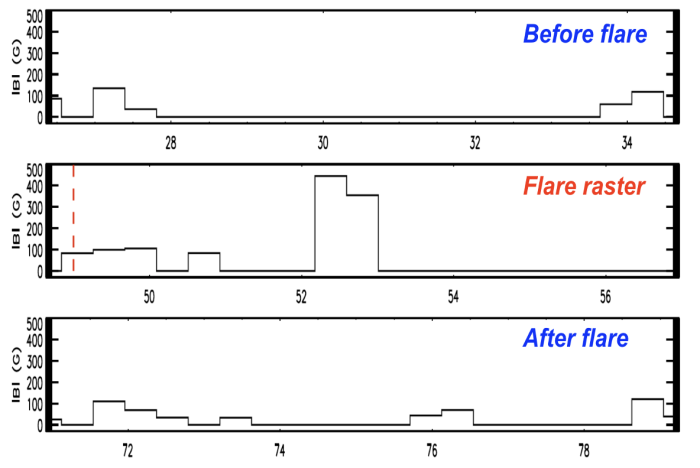A possible coronal magnetic flare precursor
| Nugget | |
|---|---|
| Number: | 442 |
| 1st Author: | Enrico LANDI |
| 2nd Author: | |
| Published: | January 16, 2023 |
| Next Nugget: | Hard X-ray pulsations |
| Previous Nugget: | A slow HOPE with microwave context |
Introduction
Flares are one of the major manifestations of solar activity, and result in the emission of large quantities of high energy radiation (X-rays, EUV) which have multiple consequences. In fact, such radiation alters the Earths ionosphere, thus disrupting communication systems, can affect the trajectories of satellites, and poses a serious threat to the health of astronauts. In order to minimize such effects, it is necessary to predict the occurrence of a flare. Several methods have been proposed: those based on observations have relied on precursor events involving one or more properties of active regions, and more recently machine-learning algorithms have been developed utilizing long series of observations. However, we still have not found an unambiguous feature that can be used to predict the imminent explosion of a flare.
Flares are believed to be due to magnetic reconnection, whereby magnetic field lines of opposite polarity squeeze together and reconfigure, releasing a large amount of energy as thermal energy and radiation. This reconnection is expected to occur in the solar corona. Thus, it is only natural to expect that the coronal magnetic field would show some precursor feature that allows flare forecasting. However, measurements of coronal magnetic fields are scarce and very difficult to make, so that we do not have systematic measurements of the main actor in flare events.
A new diagnostic tool
Recently, a brand-new diagnostic technique has been developed to measure the magnetic field strength using the intensity ratios of a few lines of Fe X (higly ionized iron nuclei, formed at about 1 MK) observed by the Hinode/EIS spectrometer (Ref. [1]). This technique utilizes the magnetic sensitivity of an Fe X spectral line to measure the magnetic field strength in the 1 MK corona, and allows for the continuous monitoring of active regions to study whether coronal magnetic fields show any precursor activity prior to a flare. Plasma at such a temperature is present in every active region.
Ref. [2] applied this technique to active region 10969 on 24 August 2007, using scans by the EIS spectrograph at a 22-min cadence. A GOES C2.0 flare (SOL2007-08-24T07:52) erupted during the fourth scan (Figure 1), and lasted only a few minutes. Thus the evolution of the coronal magnetic field could be monitored for almost an hour before and after the event. Averaging the intensity of spectral lines along the spectrometer's slit revealed that the solar flare hae erupted at a location where a large "Magnetic Field Enhancement" (MFE) took place, in which the magnetic field strength reached almost 500 G (Figure 2).

The spectral scan taken before the flare event showed that at the location of the MFE no measurable magnetic field was present, indicating that the MFE formed within 22 minutes of the flare event. Also, after the flare the MFE was completely dissipated (Figure 2). The magnetic energy contained by the MFE was estimated to be sufficient to power the entire flare.
Conclusions
These results suggest that the coronal magnetic field in plasmas around 1 MK may provide a precursor signature of flare occurrence. If this works out favorably, an early warning for flare/CME occurrence could emerge, and in any case this behavior is already quite interesting technically as a tool for following coronal magnetic restructuring. Much work still needs to be done:
- Are MFEs common to flares?
- How much in advance of the flare event do MFEs emerge?
- Is MFE formation time correlated to the flare strength?
- Can MFE formation be predicted?
- Can MFEs be used as flare precursors in Space Weather forecasting?
So far, only one flare has been studied, and many more events need to be investigated before answering these questions.
References
[1] "Hinode/EIS measurements of active region magnetic fields"
[2] "Hinode/EIS coronal magnetic field measurements at the onset of a C2 flare"
